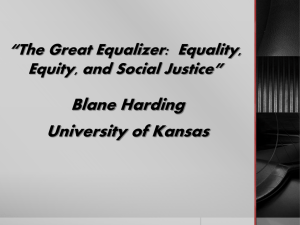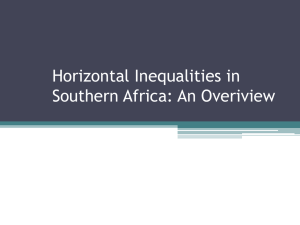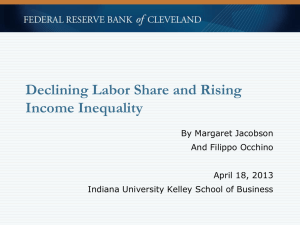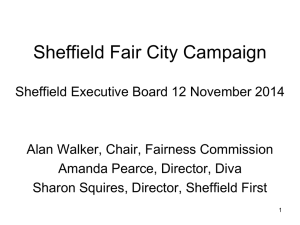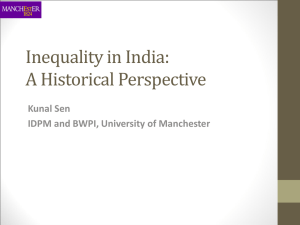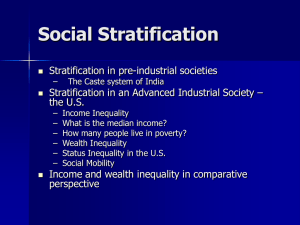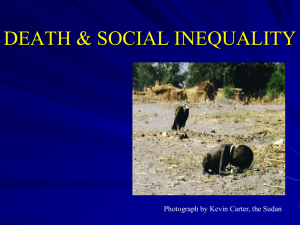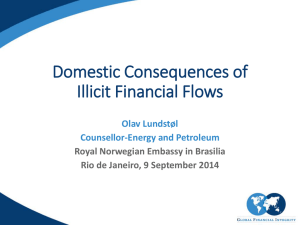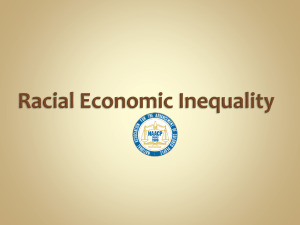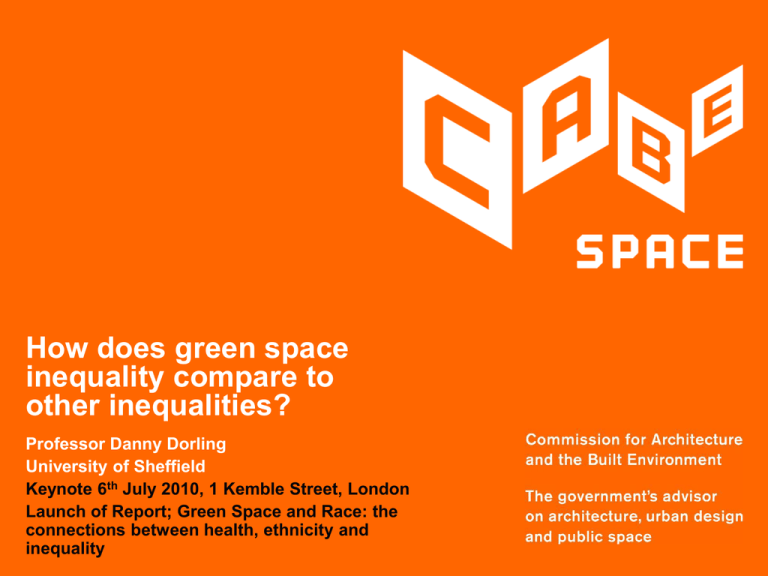
How does green space
inequality compare to
other inequalities?
Professor Danny Dorling
University of Sheffield
Keynote 6th July 2010, 1 Kemble Street, London
Launch of Report; Green Space and Race: the
connections between health, ethnicity and
inequality
How does green space
inequality compare to
other inequalities?
Professor Danny Dorling
University of Sheffield
Picture courtesy of Mike from D-fuse: www.dfuse.com
It’s always the same
places!
Hallam
Highgate
Picture from Thomas, B. and Dorling, D.
(2007) Identity in Britain, Policy Press.
Same patterns
Oxford NW
Picture from Thomas, B. and
Dorling, D. (2007) Identity in
Britain, Policy Press.
Community green: using local spaces to
tackle inequality and improve health
Intervention on people help the chances for
individuals, but may widen gaps
Interventions on places can be much longer
lasting and help far more people
Just as a land-value-tax cannot be escaped by
emigration (it is a good way to target the rich) so
creating green space in inner cities is a good way
to target poverty
Tokyo – not looking green
Tokyo – looking green
Community green
“…people living in deprived areas have five times less parks
and general public space than the most affluent 20 per cent of
areas. If you live in an area where more than 40 per cent of the
population are people from black and minority ethnic groups,
you will have 11 times less public green space than areas
where fewer than 2 per cent of their population are people from
minority ethnic groups.”
How unusual is this? The best-off fifth of people in Britain now
earn and receive 7.2 times the income of the worse-off fifth (6.9
in 1997). Is it any surprise that the best-off have access to 5
times more parks and other green space?
Source: Injustice, why social inequality persists
Living above the 4th floor
Of all the statistics revealed by the 2001
census, the starkest showed that in
England, the majority of children living on
the fifth floor or above were not of white
ethnicity.
Of all the statistics that have been
revealed since, the greatest surprise is that
the number of school children who had to
share their bedroom with an adult or
sibling over the age of 10 and of the
opposite sex rose from 8% in 1999 to
15% by 2005.
Source: Injustice: Why social inequality
persists, Policy Press,2010, page 117.
Photography by Mary Shaw
Poor housing and ethnicity
In the UK, in the eight years
between 1998-2006: “…the
number of statutory homeless
households fell by slightly
over 8% while the number of
non-white BME homeless
households increased by
14.5%.
Roberts, R. and W. McMahon (2008).
Debating race, ethnicity, harm and
crime. London, Centre for Crime and
Justice Studies. Pages 17 and 18
Homes and homelessness
There was a striking increase in
the number of homeless
African/Caribbean households of
between 25% and 42%.
The unequal distribution of
squalor continues – “33% of
Pakistanis and Bangladeshis
living in unfit dwellings compared
to 6% White”
Roberts, R. and W. McMahon (2008).
Debating race, ethnicity, harm and
crime. London, Centre for Crime and
Justice Studies. Pages 17 and 18
Poor mental health and racism
“For men and women, the rates of
admission for BME groups were
over three times higher than
average. In the ‘other Black’ group,
admission rates were ten times
higher than average”
2007
Sources:
http://www.sasi.group.shef.ac.uk/publication
s/2009/EHC_Dorling_response.pdf
Dorling and Thomas, “People and Places”
llti age 16+ 2001 %
10 - 13
14 - 16
17 - 19
20 - 22
23 - 30
llti age 16+ change %
2-5
6
7
8
9 - 11
Living behind bars
The1991 census revealed that, in
crude terms, a man was twelve times
more likely to be in prison if he were
black.
Sources: www.worldmapper.org and
Dorling, D. (1995) A New Social Atlas
of Britain, Chichester: Wiley.
By 2005, BME people accounted for
approximately 24% of the male prison
population and 28% of the female
prison population.
Living with fear and others’ fear
“Over a third of minority groups
reported experiencing overt racism in
Britain in 2005. At least five times as
many racially motivated crimes
occurred as were reported.”
In 2007, 30% of “movers and shakers”
in London would not vote for a
Mayoral candidate who was a Muslim.
“Lembit Opik: I’ll stand in race for
Mayor if London wants me”
Sources: Lewis, M. and N. Newman (2007).
Challenging Attitudes, Perceptions and
Myths. Report for the Commission on
Integration and Cohesion. London, The
Commission on Integration and Cohesion.
(page 6). Evening Standard. London.
Tuesday 13 November, 2007: pp.8-9
Discrimination in racism
“Black pupils are five times less
likely to be registered as ‘gifted and
talented’.”
Education policy, 2006
"I felt my teachers saw me as far more
threatening "
Kwame Kwei-Armah, Actor
"Black boys' performance is due to
institutionalised racism"
Courtenay Griffiths, Barrister
"Some of my best friends were racists"
Ekow Eshun, Artistic Director, ICA
Ball, S. J. (2008). The Education Debate. Bristol, Policy Press. (page 172-173,
quoting in turn from the Independent on Sunday’s release of an unpublished
Department for Education and Schools report in December 2006.
Quotations published in the Independent on Sunday in response.
2010 headlines – no let up
70% rise in number of black and Asian people
stopped and searched. Black people are now
seven times more likely to be stopped than white
people. (2008/9 compared to 2004/5)
June 17th
Black pupils are routinely marked down by
teachers. “Teachers' assessment of children's
ability is undermined by stereotyping, says
research” which compared latest SAT results to
informal assessments.
April 4th
Sources:http://www.guardian.co.uk/law/2010/j
un/17/stop-and-search-police and Asthana,
A., T. Helm and T. McVeigh (2010). The
Observer. London. April 4th.
Inequality/deprivation underlies and reflects
most of British life
Children subject to protection orders, per 10,000 (2008
orange, +2009 black)
50
45
40
35
30
25
20
15
10
5
0
1
2
3
4
5
6
7
8
9
10
Sources: CABE report and forthcoming, Areas
are local authorities ranked by same measure
Community green should still shock
despite what we already know
The inequality it reveals is high and unusually
high even compared to prejudice as measured in
schooling, crime, housing, jobs and health…
Nowhere in the UK compares to São
Paulo, Brazil …
… but are we now as unequal
as Los Angeles in the 1970s?
Source: a face map by Eugene Turner, 1977
How does green space
inequality compare to
other inequalities?
Thanks to Ben Hennig for map (equal population European topography)
Tokyo – looking very green
Tokyo – looking white
Tokyo – glass and green
Sheffield – looking very white
Sheffield – enjoying the snow
Sheffield – winter weather
How does green space
inequality compare to
other inequalities?
Professor Danny Dorling
University of Sheffield
Keynote 6th July 2010, 1 Kemble Street, London
Launch of Report; Green Space and Race: the
connections between health, ethnicity and
inequality

